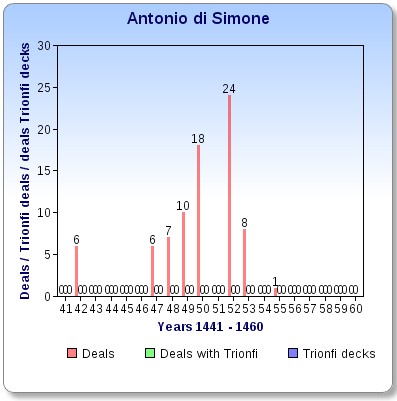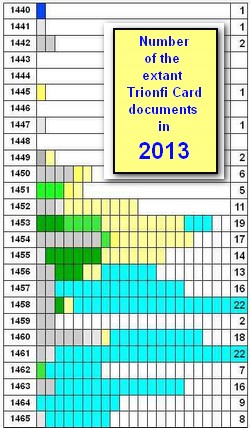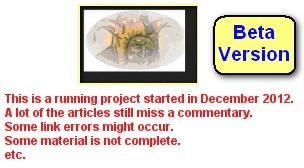Antonio di Simone, supplier of playing cards for silk dealers
composed by Lothar Teikemeier, last updated 11.12.2012
|
First recorded activity for Silk dealers: 1442-05-02 Last recorded activity for Silk dealers: 1455-04-26 |
|
Sources
Sources are mainly taken from Franco Pratesi's new article series written from November 2011 till now, published here at Trionfi.com.| SOURCE 1: Silk dealer aquire decks |
|
Quote from Franco Pratesi: "1431-1460: NAIBI ACQUIRED BY SILK-DEALERS", 20.04.2012 |
3.3 Antonio di SimoneAntonio di Simone is usually indicated as "fa i naibi", but among cards supplied by him we seldom find more than a dozen packs; usually he brings to the store a couple of packs, or a little more. On the other hand, his prices are remarkably higher than those of the other makers. We find surprising little variations around a unit price of 9s. In the course of time, this will be nearer to the common price of trionfi, than of naibi. 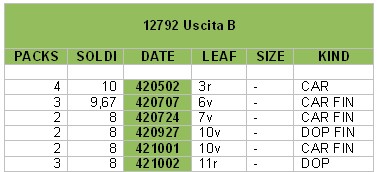 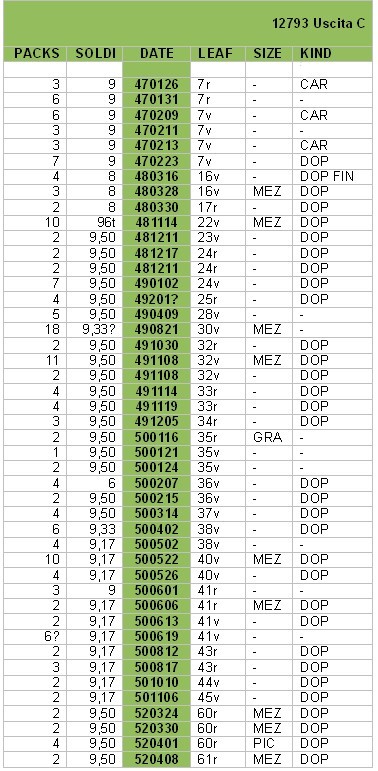 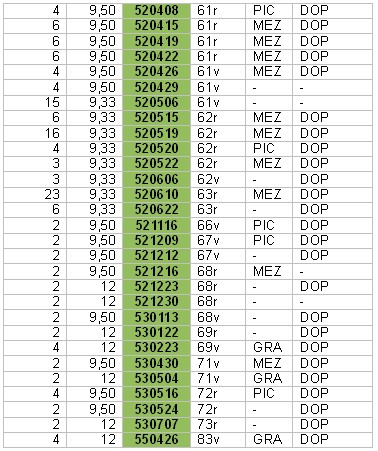 |
|
| SOURCE 2: Silk dealer sell decks |
The detail is from the Silk dealer's sales list. The red marked ADS presents "Antonio di Simone", whose decks were three times sold (1447-03-02, 1451-05-13 and 1451-07-22; the prices are 11, 10 and 10.67 Soldi). As we know about the usual prices, which went to Antonio di Simone, we may assume, that the silk dealer took a margin of c. 1 - 1.5 Soldi for a deck in the class of c. 10 Soldi.
Source: Franco Pratesi: "NAIBI SOLD BY SILK-DEALERS", 03.03.2012
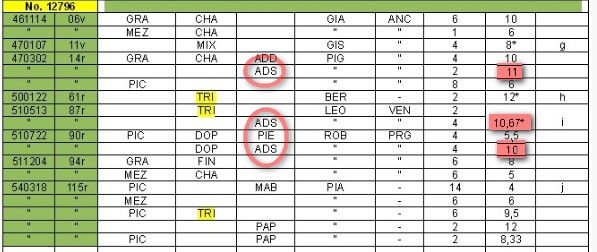
| SOURCE 3: Silk dealer aquire decks (Uscita A) |
Antonio di Simone is likely the son of Simone di Ser Antonio Fazi, who sold 4 worthwhile decks of the price of 20 Soldi at 1437-11-02.
|
Quote from Franco Pratesi: "1431-1460: NAIBI ACQUIRED BY SILK-DEALERS", 20.04.2012 |
2.1 From book 12791 – Entrata e Uscita AThis book(7) seems to be the first of a series of three similar books, but actually is of a different kind. Its contents are actually various: initially we have about thirty leaves of receipts, then four leaves beginning with number 25 with entries of the same kind as the following books, then many further pages of expenses for production, and similar matters. In other words, this whole book is interesting for us just due to its leaves 25 to 29, and it is from there that I have deduced the following table. 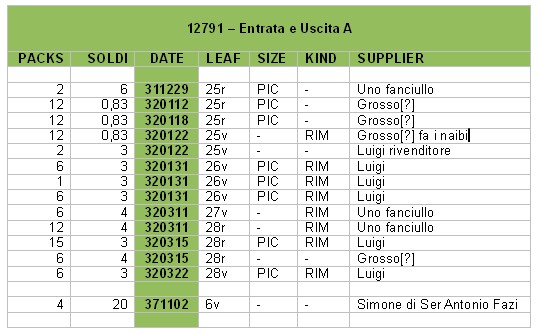 The corresponding dates are earlier than the limits indicated for the book and also earlier than most of the other records that I could study up to now - even the suppliers are not the same as we find later on. Luigi rivenditore certainly was not a cardmaker, but just a small retailer. Grosso[?] is thus the only maker recorded here; we have not yet encountered him elsewhere, and even his name, or nickname, is uncertain. Uno fanciullo, a boy, as a supplier of goods, is a rather frequent occurrence; unfortunately for us, any such indication does not help to trace the makers of the products. |
|
Repeated Note: When Ross Caldwell and me in 2003 started to collect Trionfi notes between 1442-1463, we had about 27/28 entries (which I nowadays would count as 31). The major part were the documents of Ferrara, which were collected by Gherardo Ortalli and Adriano Franceschini in the "Prince and the Playing Cards" (1996), after the base laying works of Michael Dummett and Stuart Kaplan around 1980. This collection included 2 notes about Trionfi cards in Florence, found by Franco Pratesi in his earlier work (allowances of the Trionfi game in 1450 and 1463). A graphical representation of this time (with 27 entries) shows the dominance of Ferrarese documents (in black) with a few notes only from other locations (in red; see picture to the right) In the period 2004 till October 2011 it was possible to add 4 further notes (Siena 1452, Padova 1455, Ancona c. 1460 and Valerio Marcello c. 1460), mainly thanks to information given by Thierry Depaulis. Franco Pratesi started his new article series in November 2011. Since then the list has gotten 67 new documents till September 2012 (65 of them found by Franco Pratesi, one, now the oldest of September 1440, by Thierry Depaulis, and another one by Veber Gulinelli, who controlled the earlier work of Franceschini and found an overlooked document) and nearly all are related to Florence or its surrounding. A small book (118 pages) was published around Christmas 2012, Franco Pratesi: "Playing Card Trade in 15th Century Florence" as IPCS Paper No. 7 (ISSN 0305-2133). It contains some of the articles, which before had appeared at this website, those, which treat the early time of 15th century. Thierry Depaulis commented in his foreword: "This book is a landmark in the history of early playing cards in Italy". Well, maybe not the book, but the research is clearly a landmark in various interests. For the collection of early Trionfi notes it somehow means, that we have within the year 2012 about 200 % more data for the period 1440-1462 than mankind had collected in the 200 years before. Added later: In August 2013 the new report of Arnold und Doris Esch: "Aus der Frühgeschichte der Spielkarte. Der Import von carte da giocare und trionfi nach Rom." in Gutenberg Jahrbuch 2013, 88. Jahrgang, p. 41-53, arrived in our redaction. It contains 106 new references to Trionfi decks, which all were found in the customs registers of the city Rome for the period 1453-1465. With this the number of all earlier Trionfi cards records has been doubled and should have reached then c. 210 (from which a few are only considered to be "Trionfi card notes" and don't contain the word "Trionfi" or something similar). *********** I'd started to sort the new Trionfi card documents overview in October 2012. Articles will be possibly changed according improvements in research. |
|
